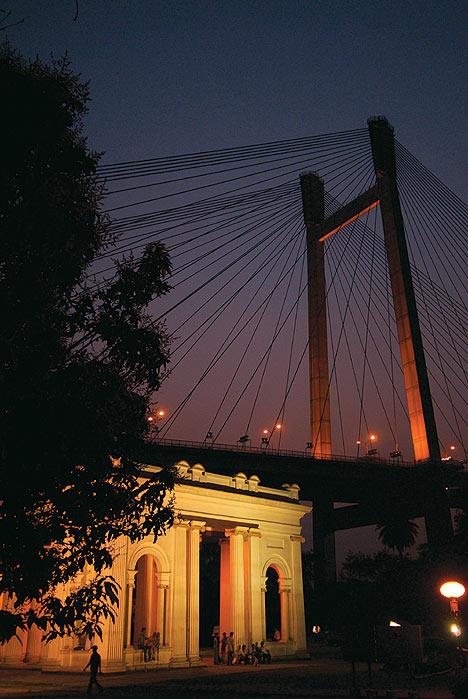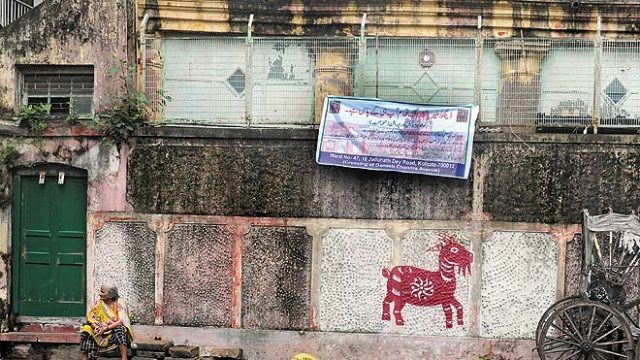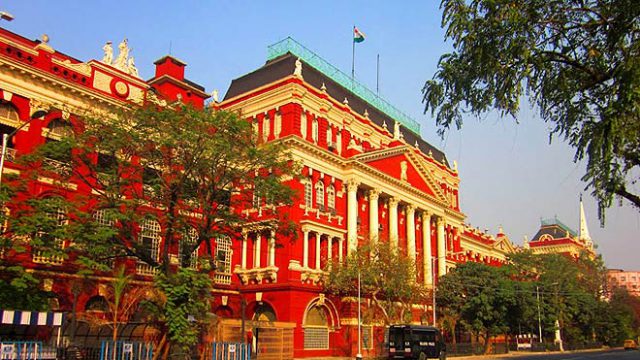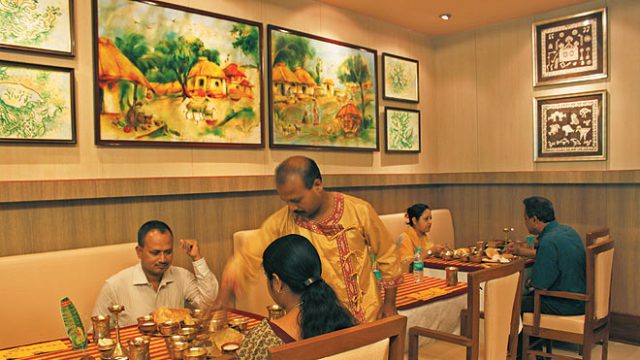I first saw Roxburgh House from the river. It stood at the water’s edge inside the Botanical
I came to know later that this house was built in 1794 for the Gardens’ first full-time superintendent William Roxburgh, author of Flora Indica — the founding text of Indian botany. And that he did much of that work in this house where he lived for nearly 20 years and started the first herbarium outside Europe. And how he raised a large family here and on his deathbed back in Scotland longed to return to his “Paradisus on the river Hooghly”. But all that came later. At that first sighting, my instinct was to simply salve the anguish of a bereft veranda on the river. The house was not ready for entry, but enter I did. As I gingerly climbed the vast wooden staircase, the creaks echoed through the cavernous empty rooms. Through an arched doorway, past an ornate fireplace, I emerged onto the half-shuttered veranda. A woman in a passing ferry looked up and saw the veranda empty no more.
Colonial Calcutta was a spectacular river-city. A 19th-century float up the Hooghly would take you past suburban Garden Reach, studded with riverside garden villas of the merchant-princes; past the masts of tall ships moored at Hastings; past the central business district along the Strand — a blur of arches, columns and finials of exquisite Victorian edifices; past the ‘Black Town’ at Chitpur with its elegant ghats; past the imposing mansions of the jute lords of Baranagar. By the time you moor near the ancient panchavati banyan at Dakshineshwar, your lower jaw would need to be collected from the bottom of the boat.
If you took the same float today, what would you see? The river remains equally majestic. But as Calcutta has turned inexorably away from the river, the riverfront has become a study in dereliction of beauty. Many of these reminders of colonial iniquities have been torn down. Some limp along, infected with asbestos and plywood, until a violent fire puts it out of its misery—like the magnificent 107-year-old Strand Warehouse that died on Valentine’s Day 2010. But a handful of these colonial river-beauties survive, easily upstaging everything we have built on the river post-independence. Each is like Gayatri Devi at 70 — indisputably over-the-hill but exuding tremendous hints of the heat in her prime. And the promise of a million stories.
If you cross the Hooghly from Roxburgh House, you will arrive at moth-eaten Metia Bruz, which in Roxburgh’s time was lined with elegant villas where the fashionable Calcutta British gathered for garden parties. This changed abruptly in 1856 with the arrival of the deposed Nawab of Awadh, Wajid Ali Shah. As the Nawab bought up properties to settle his large entourage, Metia Bruz morphed nearly overnight from a British garden district into a mini-Lucknow. Calcutta was introduced to Awadhi biriyani and zardosi karigars, mushairas and mujras, and was hopelessly smitten. The Nawab had built over 20 voluptuous palaces along the Garden Reach shore. After his death in 1887, the British levelled them and built jute mills and dockyards in their place. But one house survives because it predated the Nawab: his beloved ‘Parikhana’. Known today as BNR House, it is the residence of the General Manager of SE Railway.
Floating upstream from Metia Burz towards Garden Reach, you cannot miss BNR House. Strikingly white, set within a verdant garden at the water’s edge, its dainty colonnaded porch will lift your spirits. The house was built in 1846 for the then Supreme Court Chief Justice Lawrence Peel, who lived here until 1855. The Nawab filled this pretty house with nubile women, kathak and thumri. Parikhana is where his paris were given taalim by the ustads, and the Nawab denied entry to all else. Floating past BNR House on a moonlit night, it is easy to imagine the Nawab in the garden surrounded by his favourite paris, singing “Babul mora, naihar chhooto hi jay”.
A jot upstream from BNR House are two bungalows that currently house officers of SE Railway, innocuously named No. 12 and No. 13. Their past is less innocuous. No. 12 was the immigration depot for ‘coolies’ bound for Fiji and No. 13 for Trinidad. V.S. Naipaul’s maternal grandfather, recruited at Banaras and shipped to Trinidad in 1894, was likely registered at No. 13. This is the place were Draupadi from Gorakhpur would turn irrevocably into Droopatty, Fakir from Munger into Fuckyeah — brain-teasers for their descendants to nut out a century later.
Heading north, look right as you pass under the cable-stayed second Hooghly bridge. You’ll see a stately Ionic colonnade built in 1843 to memorialise James Prinsep, who deciphered the Brahmi script and thereby Ashoka’s edicts. Right next to the Prinsep Memorial was Takta Ghat — plank ghat — where political prisoners would board ships bound for the Andamans, their ankle chains jangling on the sagging plank. Coolie ships bound for the Caribbean would dock a bit downstream at Hastings, where the Tolly’s Nullah empties into the Hooghly. The Caribbean crossing took up to six months and sometimes killed a full third of the ‘cargo’. The faces of the British Empire are juxtaposed here in a tight cluster. Prinsep’s memory survived; the others did not.
On the stretch of the river between the second Hooghly and Howrah bridges, you will float north along the Strand. At Babughat, your field of vision will be dominated by the towering mansard roof of the Calcutta High Court, extra imperious under a fresh coat of paint. But if you happen to look down, you’ll see streams of human waste drain directly into the river, blending seamlessly with its all-forgiving turbidity. This is better than the tonnes of industrial effluvia from the numerous jute mills that used to line her shores, or the thousands of corpses that would be sent to her to work on. She has atomised them all and has charmed the fish to stay, and consequently the dolphins. Each time I see the graceful arc of a breaching dolphin I hear the river say, bring it on.
When you arrive at the Howrah bridge, the scene at the Mullick Ghat flower market will seem straight out of Emily Eden’s sketchbook, circa 1837: men bearing fat ropes of marigold twisted into enormous fluffy coils, their yellow and orange glinting in the sun; women, statuesque in wet cotton, three-dipping in the river. With the vast silver bridge spread-eagled above. Just a tad north, once visible from the river, is the Old Mint that served from 1829 to 1952. Don’t stand too close or all you’ll see is one of its 40 massive Doric columns. Step back across Strand Road to fully regard this breathtaking colonnaded portico, a copy of the Temple of Minerva in Athens. In December 1918, it produced 1,90,000 finished coins in one day, a world record. Abandoned since 1952, it is occupied now by the Central Reserve Police Force and bears their standard décor of concertina wires and sandbagged gunners.
Beyond the Howrah bridge, you will float past the Nimtolla burning ghat into the heart of north Calcutta, the locus of 19th-century Bengali wealth. At the Shobhabazar ferry jetty, look up at the glorious but derelict Victorian mansion that dominates the river bend. Putul Bari’s ornate terrace juts out into the sky, with a clutch of dancing figurines. Inside, the two top floors are held up by Corinthian columns surrounding a charming inner courtyard. The resemblance between the house and its owner is eerie. Makhan Lal Natta, 78, owns the venerable Natta Company that for the past 140 years has been a leading exponent of jatra — a Bengali folk theatre form. But jatra’s heyday is decidedly over and Natta is bemused by the government’s ‘heritage’ tag on his property. “Just the other day I saw another statue crumble,” he says. Not 20 feet away, on the Circular Rail track along the river, a train trundles by adding a few more cracks to his house.
North of Shobhabazar and Bagbazar you will float past the Chitpur lock gates, the northern limit of the old city. Beyond this was once the playground of the rich and is now the land of factories: most dead, some alive. Belur will soon pass by on your left and Bally bridge will loom ahead with Dakshineshwar beyond it. Just before the bridge, on your right is Tagore Villa. Much more a palace than a villa, this towering confection of arches, rotundas and balustrades was once a nilkuthi — indigo plantation — before it became the summer retreat of the Pathuriaghata Tagore family in 1853. At the height of the Naxal troubles in 1971, the family sold the property to the government, perhaps to avoid being conspicuously bourgeois. It is now a Border Security Force camp; the commandant occupies the river-facing suite upstairs. From the filigreed verandas, laundry — that most proletarian of flags — flutters happily in the breeze.
I spent a night in the room Rabindranath always occupied when he came to his cousin’s river retreat. It opens out onto a spacious circular porch overlooking the river. At dusk, as a plaintive bugle sounded the flag-down ceremony, I felt a stab of ownership over the scene around me: the molten gold in the water, the silhouetted lone fishing boat, the lights on Bally bridge an ellipsis into the night. And I could see what propelled Rabibabu to write in this room: jakhon porbena mor paer chinha ei batey — when my footprints will fade from this house.
If this 21st-century float up the Hooghly leaves you weighed down by so much beauty so close to extinction, don’t expect the river to commiserate. History is rife with cities left destitute when their mother river altered course. But a river doesn’t flinch when the city that it nourished turns away. When I pay close attention, I see the river patiently waiting for these last bastions to crumble, to be unburdened of a has-been river-city that comes to her only in defecation and death. And I hear her playfully gurgle, boye geche — I don’t give a damn.
A ride on the Hooghly from the Botanical Gardens to Dakshineshwar would take about five hours in a country boat if the tide was with you, more otherwise. Country boats can be rented at Outram Ghat for Rs 250-350 per hour. Feel free to haggle.
Dakshineshwar
Hooghly
Leave a Reply
You must be logged in to post a comment.





